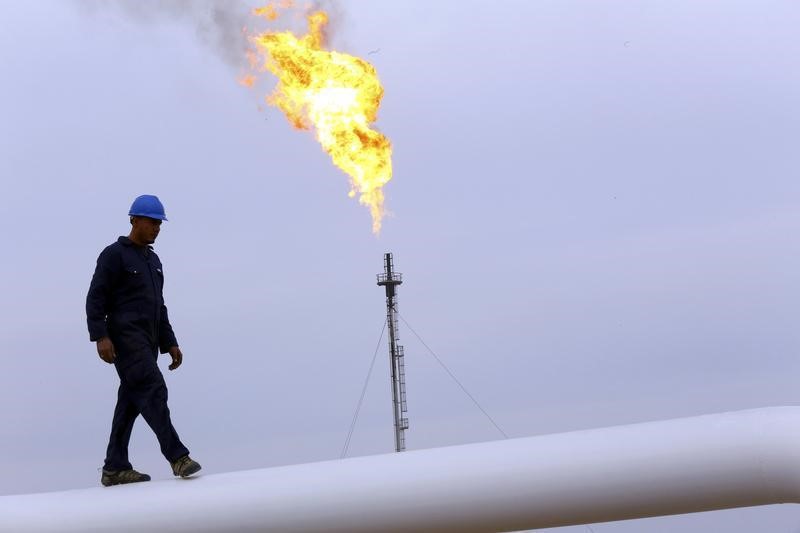Investing.com -- It’s one thing to run ahead of the pack. It’s another to do so with the blinkers on, as oil bulls demonstrated Wednesday, charging into higher territory by ignoring bearish U.S. inventory data and a Fed official’s caution that cooling inflation did not mean the central bank was ready to stop rate hikes.
New York-based West Texas Intermediate, or WTI, crude settled up 92 cents, or 1.2%, at $75.75 per barrel. WTI earlier hit $76.08, its highest since April. The U.S. crude benchmark is up 2.6% on the week, extending last week’s 4.6% rally.
London-based Brent gained 71 cents, or 0.9%, to finish the New York session at $80.11, after a near three-month high of $80.49. For the week, Brent is up 2% after last week’s 4.8% rally.
Oil’s latest run-up came after the Labor Department reported that the U.S. Consumer Price Index grew by just 3.0% in the year to June, expanding at its slowest pace in more than two years. Annual CPI was at 4.0% in May.
Even so, core CPI, measured by excluding volatile food and energy prices, rose 0.2% for May and was still up 4.8% from a year ago — more than double the Fed’s 2% target. That was an indication that while price pressures had eased in general, consumers were probably paying more than they should for everything, from what they stock in their refrigerator to what they put in the tank of their cars.
“Inflation is still too high,” Tom Barkin, Fed president for the region of Richmond, said at an event that began just after the release of the CPI data. “The demand seems to be settling down, but [the Fed] still looking to be convinced that will feed through to inflation. Demand remains elevated at the same time supply is constrained, the process of getting back to balance has been slow.”
Fed’s Barkin says not time yet to stop rate hikes
Barkin also indicated that the Fed, which paused rate hikes in June to study its impact, will resume monetary tightening to get inflation back to its target. The central bank’s policy-makers will make their next decision on rates on July 26. Investing.com’s Fed Rate Monitor Tool assigned a 94% probability of the central bank doing a 0.25% hike at its July policy meeting.
The Fed’s tolerance for inflation is, meanwhile, just 2% per annum. In response to the runaway price growth caused by relief spending related to the coronavirus pandemic, the central bank has raised interest rates 10 times in March 2022, adding 5% to rates from a previous 0.25%.
“We are comfortable doing more with policy if incoming data does not confirm inflation will return to target,” Barkin said on Wednesday. “Backing off too soon would require the Fed to do even more [later]. It is still a question whether inflation can settle while the labor market remains as strong as it is.”
Aside from Barkin’s commitment to staying the course on rate hikes, oil longs also ignored something as or more pertinent — U.S. inventory data.
U.S. crude oil inventories jumped by their most in four weeks as early summer demand for motor fuels appears to have peaked after weeks of heavy processing by refiners trying to ensure adequate supply to market, the Energy Information Administration, or EIA, reported.
Stocks of gasoline were flat from a week earlier and those of distillates surged their most in five weeks, the EIA said in its Weekly Petroleum Status Report.
The U.S. crude inventory balance jumped by 5.946 million barrels during the week ended July 7, versus the 1.508M barrel draw during the prior week to June 30. Industry analysts tracked by Investing.com had forecast a build of only 0.483M for last week.
The crude draw reported by the EIA also came with its usual caveat — a release of crude from the U.S. Strategic Petroleum Reserve. But even that this time was marginal, amounting to just 0.4M barrels. If that was subtracted, the overall crude build would still be 5.5M or so.
Even exports -- one of the brightest spots of the U.S. oil market -- were weak, with crude shipments down 1.757M barrels daily to 2.144M. Just a few weeks ago, crude exports were near the March all-time high of 4.5M barrels per day.
On the fuels side, gasoline inventories were unchanged from the week earlier, the EIA said. Analysts had expected the agency to cite a draw of around 730,000 barrels instead, to add to the prior week’s pull of 2.55 million barrels. Automotive fuel gasoline is the No. 1 US fuel product.
“Horrible, horrible demand numbers for gasoline”
Worse, in terms of products supplied to the market — an indicator of demand at the pump, there was a drop of 0.844 million barrels daily to 8.756M per day and against last week’s 9.599M. That 8.756M was one of the lowest for an early summer season.
“These are horrible, horrible demand numbers for gasoline,” said John Kilduff, partner at New York energy hedge fund Again Capital. “If the uptake doesn’t pick up, prices will probably be stuck again like before, this time at mid-$70 levels instead of the previous low or sub-$70s.”
In the case of distillate stockpiles, the EIA reported a build of 4.815M barrels. Analysts had forecast a draw of 0.262M barrels last week, against a previous drop of 1.045M. Distillates are refined into heating oil, diesel for trucks, buses, trains and ships, and fuel for jets.
